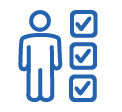Begin Your Learning Journey
Partnership career advisors are here to help you take the next steps in your education, from clarifying your goals to selecting the right pathway and school. Whether you’re exploring short-term certifications or advanced degrees, our advisors offer personalized guidance at every stage.
Education Planning Process
Take these steps to return to learning and accomplish your career goals. Our advisors will guide you through each step of the education planning process.
Step 1
Identify Your Motivation
Step 2
Explore Career Options
Step 3
Decide on an Education Pathway
Step 4
Choose a Learning Institution and Start Your New Program
Step 1: Identify Your Motivation
First things first - Clarify what will drive you, envision your desired outcomes, and begin to consider challenges that may impact your return to learning.
Our Advisors Can Help:
- Discuss ways to manage financial constraints, time, and work-life balance.
- Address concerns about returning to school and simplify the steps to start.
- Suggest free resources like the Partnership’s Skills for Success courses and Online Learning Certificate Programs to improve skills and ease back into learning.
- Explain the Partnership’s Tuition Benefits Program so you can save on education costs and exam fees.
Step 2: Explore Career Options
Next, explore your career options to define your career goals and identify the steps needed to reach them.
Our Advisors Can Help:
- Write SMART goals that align with both long-term (5-year plan) and short-term (6 months – 2 years) ambitions.
- Determine the education and training requirements for your chosen career path.
- Connect with additional resources like the Career Mobility Office (CMO) and the Glossary of Titles - Inquiry Tool (GOT-IT).
Step 3: Decide On an Education Pathway
Once you have career goals and an action plan, research different educational paths to find the right fit for your goals.
Our Advisors Can Help:
Clarify options based on your career objectives, from short-term training to degree programs.
- Professional development (conferences, workshops, etc.)
- Certificate programs
- Vocational learning programs
- Micro-credentials (SUNY)
- Associate’s, bachelor’s
- Advanced degrees
Note: Many options are “stackable,” allowing you to build over time at a pace that fits your lifestyle.
- Develop timelines and create an action plan.
Step 4: Choose a Learning Institution and Start Your New Program
Now it's time to select the right education program, school, or institution that best supports your learning preferences, schedule, and financial needs.
Our Advisors Can Help:
- Match your preferred learning style (online, hybrid, or in-person) with available options.
- Explore eligibility for free education programs like the New York State Opportunity Promise scholarship, SUNY Reconnect.
- Compare financial costs, identify financial assistance opportunities, complete the Free Application for Federal Student Aid (FAFSA), and determine flexible payment strategies.
- Guide you through the Partnership’s Tuition Benefits Program.
- Verify if your education program or institution is accredited (has suitable academic oversight), to ensure eligibility for certain credit transfers and Partnership tuition reimbursements.
- Evaluate transfer credits, prior learning assessments, and credit by exam options such as College-Level Examination Program (CLEP), DANTES Subject Standardized Test (DSST), and Thomas Edison College Examination Program (TECEP).
- Review school resources, class sizes, and support services for adult learners.
- Guide you in accessing school resources, including resource centers, Educational Opportunity Centers, and Adult Education Basic programs.
Congratulations!
As you begin your program, use your school’s resources to overcome any challenges and find opportunities to confidently support your educational journey.




